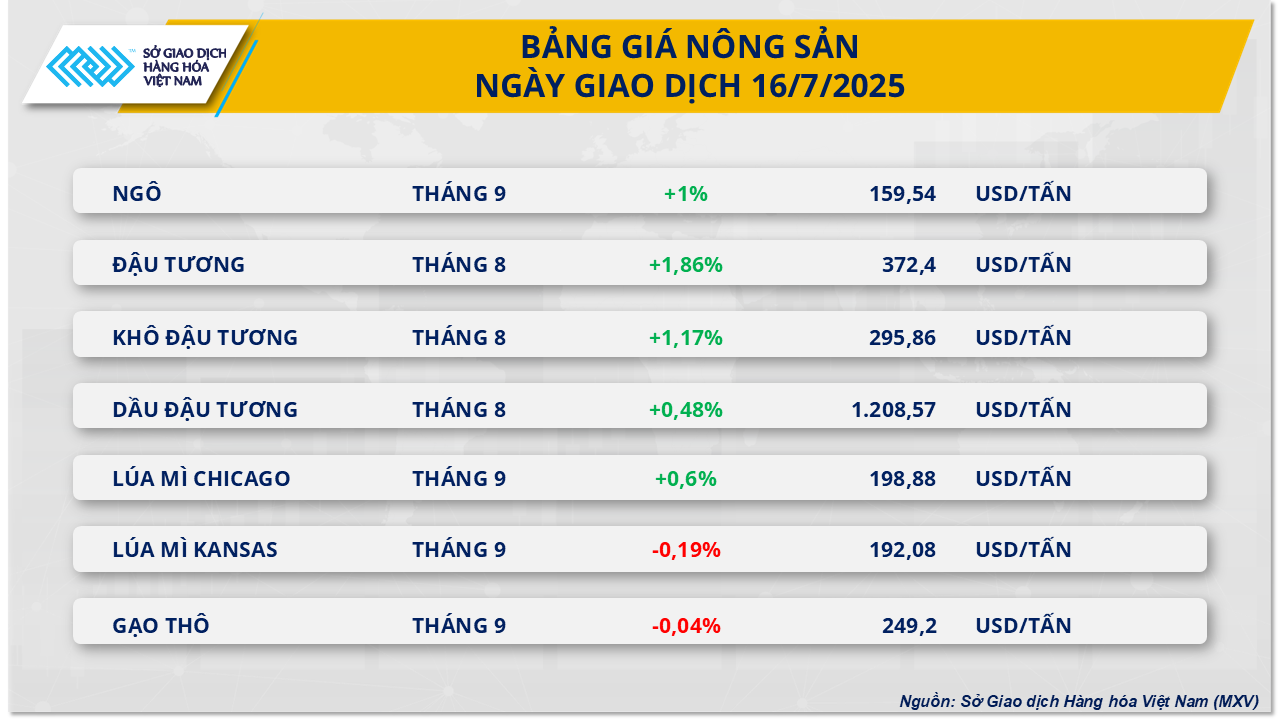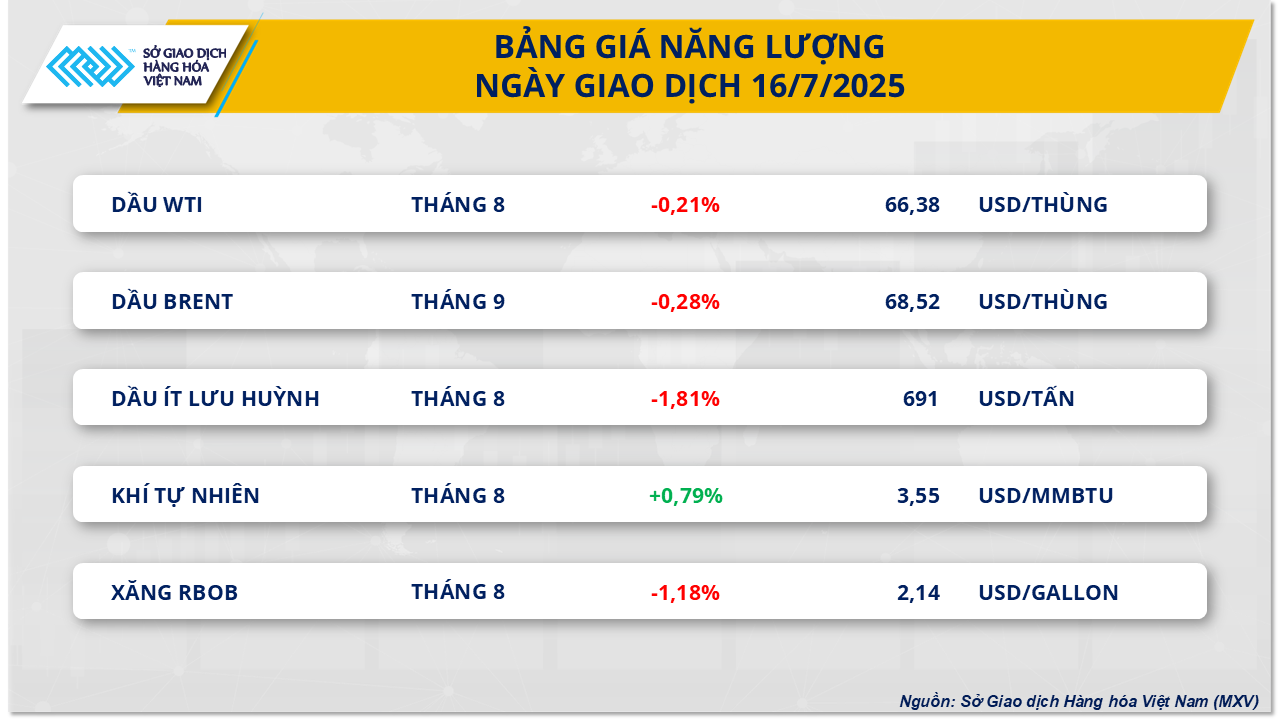Data from the Vietnam Commodity Exchange (MXV) showed that buying power continued to dominate yesterday's trading session. Notably, in the agricultural market, soybean prices turned sharply higher amid many positive signals about supply and demand. On the other hand, oil prices had a slight adjustment session as the market showed certain concerns about gasoline consumption in the US.
In the agricultural market, at the close of yesterday’s trading session (July 16), green covered most of the key agricultural products. In particular, soybean prices ended a series of three consecutive sessions of decline, recovering more than 1.8% to 372.4 USD/ton.
According to MXV, the main driver supporting the market comes from optimism after expectations that US soybean exports to China will "break the ice" in the near future. According to information from the US Department of Agriculture (USDA), the recently released daily export report confirmed that there was an order to sell 120,000 tons of soybeans to an unnamed country, for delivery in the 2025-2026 crop year. Investors believe that this is most likely an order from China - a country that often makes anonymous purchases, especially when this country is entering the peak oil pressing season, with strong demand for soybeans.
If the above hypothesis is correct, this deal will be a positive signal, showing new developments in the trade negotiation process between the US and China, and at the same time opening up expectations for exporting US soybeans to China.
In addition, the market also received significant support after the latest announcement by US President Donald Trump on the trade agreement reached with Indonesia - one of the five largest soybean import markets of the US. Accordingly, Indonesia committed to buying 4.5 billion USD of US agricultural products under the new agreement, aiming to expand the access of US agricultural products to the market of more than 280 million people. This also shows that the prospect of consumption demand of this country in the coming time is quite good.

On the other hand, global supply is showing signs of increasing as the Rosario Grain Exchange (Argentina) has just adjusted its forecast for soybean production in the 2024-2025 crop year to 49.5 million tons, an increase of 1 million tons compared to the previous forecast.
In the domestic market, the price of dried soybeans recorded at Vung Tau port on July 15 was VND9,300/kg, while at Cai Lan port it was VND9,400/kg. Compared to the previous session, the price decreased slightly by VND50-100/kg, but in general, it has remained stable over the past month.
According to data, dry soybean inventories in Vietnam are currently at very high levels, while domestic selling prices are significantly lower than cost prices, causing many trading enterprises to fall into losses. Some importers have been forced to divert their ships to other markets to reduce the pressure of oversupply in Vietnam.
Specifically, in July, there will be no more ships carrying US soybean meal arriving at Vietnamese ports, causing the total supply for the month to reach only about 364,000 tons. If this trend continues into August and there are no US goods arriving, the amount of imported soybean meal could drop to about 310,000 tons - the lowest level in many months. This will be a factor to monitor, because if domestic inventories begin to be cleared, the price level could soon recover.
Regarding the energy market, according to MXV, at the end of yesterday's trading session, the energy market witnessed overwhelming selling pressure when 4 out of 5 commodities in the group simultaneously weakened. In particular, world oil prices had a slight decrease in the context of investors being cautious about signals about fuel consumption demand in the US.
At the end of the session, both major crude oil products decreased slightly by less than 0.3%. Specifically, Brent oil price stopped at 68.52 USD/barrel, corresponding to a decrease of 0.28%; while WTI oil price recorded a decrease of 0.21%, down to 66.38 USD/barrel.

According to the latest report from the US Energy Information Administration (EIA), in the week ending July 11, commercial crude oil reserves in the US fell sharply by 3.86 million barrels, contrary to the American Petroleum Institute (API) estimate of an increase of up to 19.1 million barrels.
However, it is worth noting that the data also showed that gasoline inventories in the US increased by 3.4 million barrels, despite the fact that the supply from refineries decreased by more than 800,000 barrels. Distillate fuel inventories also increased by 4.17 million barrels, accompanied by a decrease of more than 100,000 barrels. The above information has raised some concerns about the situation of gasoline consumption of Americans during the peak travel season.
However, energy demand has been supported by a better-than-expected economic performance in China, the world’s largest crude importer, with both the International Energy Agency (IEA) and the Organization of the Petroleum Exporting Countries (OPEC) reporting that global oil demand will continue to grow steadily, at least in the short term.
Meanwhile, the decline in oil prices was also restrained by rising expectations that the US Federal Reserve (FED) will cut its key interest rate, currently at a high level of 4.25-4.5%, starting in September at the latest. Inflation in the US is relatively stable, according to the Consumer Price Index (CPI) group released on July 15. In addition, the FED is also under pressure from the administration of US President Donald Trump to sharply cut interest rates.
Source: https://baolamdong.vn/thi-truong-hang-hoa-17-7-luc-mua-tiep-tuc-chiem-uu-the-382580.html




































































































Comment (0)